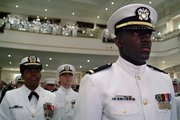Reserve Officer Training Corps
|
|
The Reserve Officer Training Corps (ROTC) is a training program of the United States armed forces present on college campuses to recruit and educate commissioned officers. It is designed as a college elective, and studies focus on leadership development, problem solving, strategic planning, and professional ethics.
ROTC produces 60 percent of all officers in the U.S. armed forces, and 75 percent of U.S. Army officers.
Each of the services offer competitive, merit-based scholarships to ROTC students, often covering full tuition for college.
U.S. Army and U.S. Air Force ROTC students are referred to as cadets, while U.S. Navy ROTC students are known as midshipmen regardless of their sex. US Marine Corps officer candidates commission through the Naval ROTC program.
Army units are organized as Brigades and Battalions. Air Force units are "Detachments" with the students organized into Wings, Groups, Squadrons, and Flights, like the active Air Force. Navy units are called NROTCU with an abbreviation of the host University or College. For example, the University of Minnesota unit is "NROTCU UNIV OF MN." The students are organized as a battalion. If the Marine students are integrated with the Navy students, there are companies, but having the Navy students in Departments and Divisions like a ship, and the Marines in a separate company is not unknown.
| Contents |
U.S. Army ROTC History
Rotc.jpeg
The concept of Army ROTC began with the Morrill Act of 1862 which established the "land grant" colleges. Part of the federal government's requirement for these schools was that they include military tactics as part of their curriculum. However, Army ROTC as we know it today was created by the National Defense Act of 1916 and commissioned its first class of lieutenants in 1920.
In 1960 General George H. Decker, ROTC commissionee at Lafayette College, became the first ROTC graduate named Chief of Staff of the Army. Other Army Chiefs of Staff to come out of ROTC include General Fred C. Weyand (University of California-Berkeley) and General Gordon Sullivan (Norwich University). General Colin Powell, ROTC commissionee at the City University of New York, served as Chairman of the Joint Chiefs of Staff during Operation Desert Storm and later as Secretary of State from 2001 - 2005. General Hugh Shelton, commissioned out of North Carolina State University, was also a Chairman of the Joint Chiefs of Staff. The college ROTC program to produce the most 4-star Army generals is North Carolina State University, second only to the United States Military Academy in the number of 4-star generals produced. The University of Oregon has produced the highest number of general officers out of the nonmilitary ROTC schools, with a total of 44 flag officers.
Concerted efforts are being made at some Ivy League universities that have previously banned ROTC, including Harvard and Columbia, to return ROTC to campus. The program was expelled from many colleges and universities during the Vietnam War. In the 21st century, the debate often focuses around the law signed in 1993 by President Bill Clinton which requires the military to discriminate based on the declared sexual orientation of its members (see Don't ask, don't tell). Some schools believe this legal mandate would require them to waive or amend their non-discrimination policies.
U.S. Air Force ROTC History
Aetc2.jpg
(As quoted from Air Force ROTC's Official Website (http://www.afrotc.com/overview/history/)) The first Air ROTC units were established between 1920 and 1923 at the University of California at Berkeley, Georgia Institute of Technology, the University of Illinois, the University of Washington, Massachusetts Institute of Technology, and Texas Agricultural and Mechanical College. After World War II Gen. Dwight D. Eisenhower, chief of staff of the War Department, signed General Order No. 124, establishing Air ROTC units at 77 colleges and universities throughout the nation.
The Air Force ROTC Vitalization Act of 1964 authorized a new two-year Senior Program, scholarships and a Junior Program. An experimental program to commission women through Air Force ROTC was first conducted from 1956 to 1960. Women were again enrolled in the Senior Program, starting in 1969, and in the Junior Program four years later. Eligible Air Force enlisted men and women pursuing a college degree who are interested in becoming commissioned officers are given that opportunity through competition in the Air Force ROTC Airman Scholarship and Commissioning Program, established in 1973. In 1978, Air Training Command, with headquarters at Randolph Air Force Base, Texas, assumed responsibility for the Air Force ROTC programs.
On July 1, 1993, Air Training Command merged with Air University to form Air Education and Training Command. Air University became a direct reporting unit under Air Education and Training Command, and Air Force ROTC realigned under Air University. In February 1997, in an effort to reduce duplication of effort and streamline administrative and reporting procedures within Air University, Air Force ROTC and Officer Training School realigned under the newly created umbrella organization, Air Force Officer Accession and Training Schools. This restructuring placed oversight for three-quarters of Air Force officer production under one command, the AFOATS commander—a brigadier general.
U.S. Naval ROTC History
The U.S. Naval ROTC program was founded in 1926. In 1932 the Marine Corps joined the program, and in 1990, the first Navy Nurse Corps scholarships were awarded.
Related topics
External links
- U.S. Army ROTC (http://www.armyrotc.com)
- U.S. Air Force ROTC (http://www.afrotc.com)
- U.S. Naval ROTC (https://www.nrotc.navy.mil/)
- Advocates For ROTC (http://www.advocatesforrotc.org)de:ROTC

